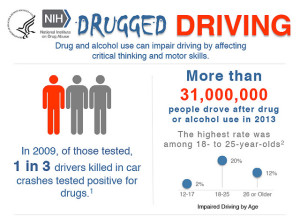
A report released by the Governors Highway Safety Association (GHSA) states that although drunk driving is deceasing across the U.S., drugged driving is actually on the increase.
This may be in response to more permissive marijuana laws that have made medical marijuana legal in 23 states and the District of Columbia, and legalized recreational use in D.C. as well as four states, among them Colorado. An increase in prescription drug abuse may also play a role: The number of prescription painkillers dispensed in the U.S. has quadrupled since 1999, according to the Centers for Disease Control and Prevention.
According to the report, approximately 40 percent of fatally injured drivers test positive for drugs, nearly the same as those who test positive for alcohol. The GHSA urges states to take action to identify drugged drivers; update drugged driving laws; provide much-needed training to law enforcement, prosecutors, and judges; increase testing; and improve data collection.
What Can States Do?
There are various things states can do to guide their response to the rising numbers of drug-impaired drivers, including:
- Reviewing data to understand current trends
- Examining and updating drug-impaired driving laws
- Providing updated training to law enforcement and officers of the court
- Testing all fatally injured drivers for the presence of drugs
- Screening and evaluating all offenders to identify any drug or alcohol problems or underlying mental health issues, and referring offenders to treatment if necessary
- Tracking all alcohol- and drug-impaired driver car accident data separately to most efficiently assess the problem
DUID Is Illegal
In Colorado, driving under the influence of any drug is illegal and is considered just as dangerous as driving under the influence of alcohol. If a driver is impaired by any type of drug, even legal drugs like marijuana and prescription medications, they can be arrested for driving while under the influence.
Colorado law enforcement officers are trained in the detection or impairment of alcohol or drugs, and many are specially trained Drug Recognition Experts (DRE). These trained officers have the ability to recognize the physical signs of drug impairment, and also use chemicals to test for drugs. If a police officer in Colorado has reasonable grounds to believe that a motorist is driving under the influence or impairment, Colorado’s Express Consent Law requires any driver to consent to a chemical test.
National Activities to Support State Efforts
The report identifies actions that are needed at the federal level to help support the efforts of the states. Some of these include:
- The establishment of a national drugged driving education program, as recommended by the Government Accountability Office
- Resources for prosecutors, judges, and lawmakers
- Standardized roadside testing policies and devices
- Guidelines regarding data collection
- Continued research on the effects of drugged driving laws and programs
- Information about the level of impairment produced by different concentrations of commonly used drugs
The GHSA report summarizes the research and data currently available, but it also brings to light how much remains to be learned about drugged driving, and what the states need to do to measure their drug impaired driving problem and shore up their efforts to detect and get drug impaired drivers off the road.
Image by nihgov.
